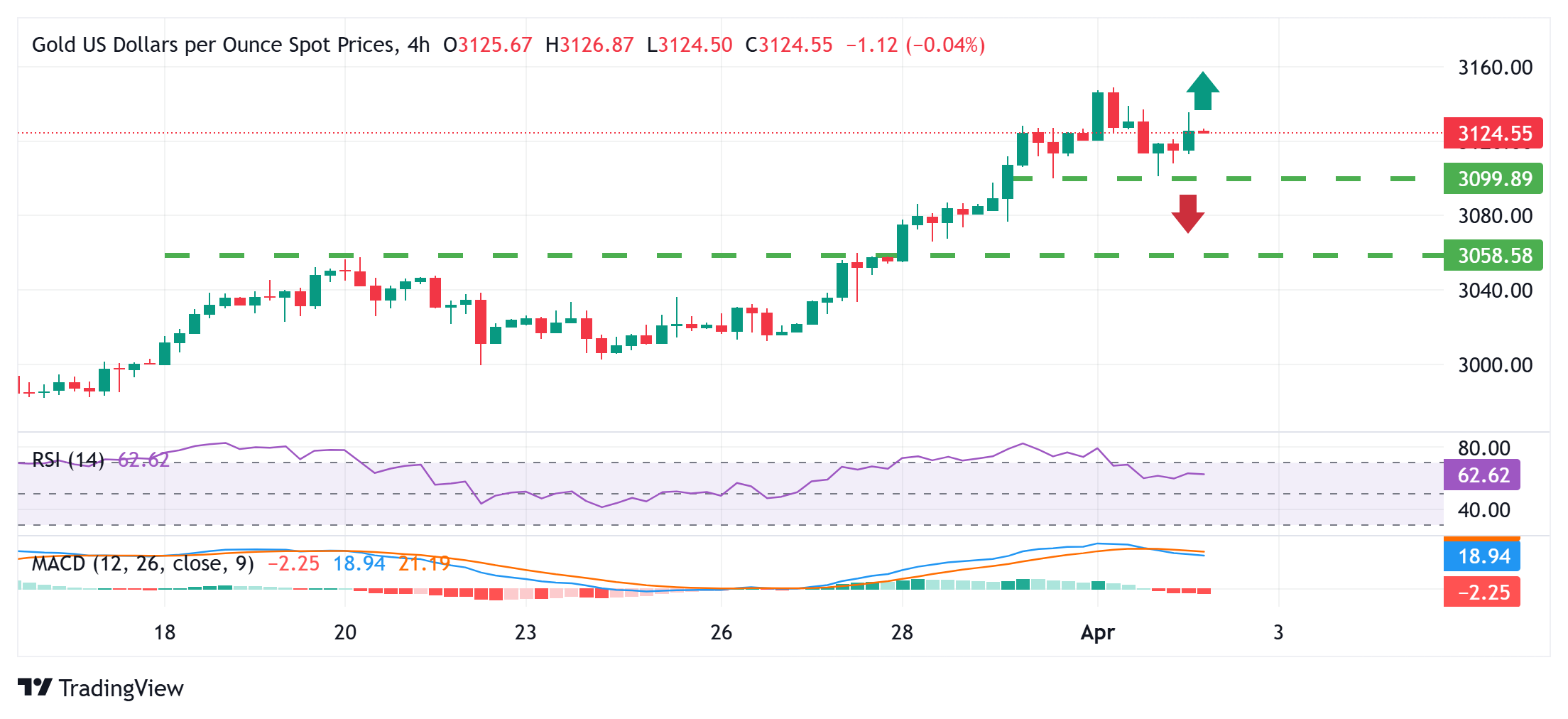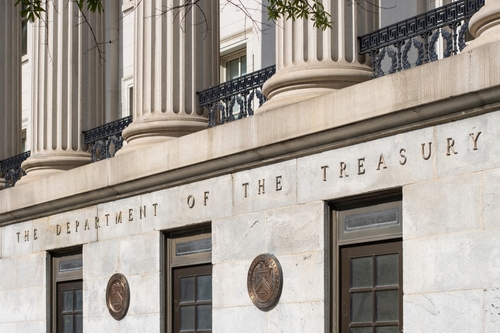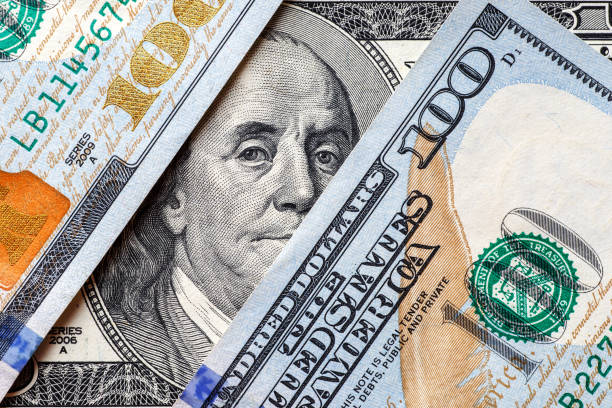Gold price remains close to record high amid concerns over Trump’s reciprocal tariffs

- Gold price regains positive traction amid concerns about Trump’s aggressive trade policies.
- Fed rate cut bets keep the USD bulls on the defensive and further benefiting the XAU/USD pair.
- A broadly stable risk sentiment might cap gains ahead of Trump’s tariffs announcement.
Gold price (XAU/USD) attracts some dip-buyers during the Asian session on Wednesday and stalls the previous day's modest retracement slide from a fresh record high. Investors continue to take refuge in traditional safe-haven assets amid the uncertainty over US President Donald Trump's so-called reciprocal tariffs and their impact on the global economy. Moreover, geopolitical tensions act as a tailwind for the bullion. Adding to this, US recession fears and the prospects for more interest rate cuts by the Federal Reserve (Fed) drive flows toward the non-yielding yellow metal.
Meanwhile, the US Dollar (USD) has been struggling to gain any meaningful traction amid the growing acceptance that a tariff-driven US economic slowdown would force the Fed to resume its rate-cutting cycle soon. This is seen as another factor lending additional support to the Gold price, though a stable performance around the Asian equity markets and overbought conditions on the daily chart might hold back the XAU/USD bulls from placing fresh bets. Investors might also opt to move to the sidelines ahead of the keenly awaited Trump administration's tariffs announcement later today.
Daily Digest Market Movers: Gold price bulls retain control as trade-related anxiety continues to drive safe-haven flows
- Investors remain worried about the potential economic fallout from US President Donald Trump's trade policies, which assists the safe-haven Gold price to regain positive traction following the overnight pullback from a fresh all-time peak.
- The recent US macro data pointed to still sticky inflation and slowing economic growth, implying that the economy could be heading towards stagflation, which might force the Federal Reserve to resume its rate-cutting cycle in June.
- The concerns were fueled by the disappointing US ISM Manufacturing Purchasing Managers Index (PMI) on Tuesday, which fell from 50.3 to 49 in March and indicated that business activity contracted for the first time in three months.
- The report also revealed that inflation at the factory gate jumped to the highest level in nearly three years and the Employment Index highlighted a decrease in the sector's payrolls at an accelerating pace during the reported month.
- Adding to this, the Job Openings and Labor Turnover Survey (JOLTS) showed that the number of job openings on the last business day of February stood at 7.56 million, down from 7.76 million reported in the previous month.
- According to the CME Group's FedWatch Tool, the markets are currently pricing in the possibility that the Fed would cut rates by 80 basis points this year, undermining the US Dollar and further benefiting the non-yielding yellow metal.
- Asian equity markets tracked the overnight gains on Wall Street, which, along with overbought conditions, might hold back the XAU/USD bulls from placing fresh bets ahead of Trump's impending reciprocal tariffs announcement.
- In the meantime, the release of the US ADP report on private-sector employment and Factory Orders data might influence the USD, which could provide some impetus to the precious metal later during the early North American session.
Gold price constructive setup backs prospect for additional gains; overbought daily RSI warrants caution

From a technical perspective, the overnight pullback from the all-time peak stalled near the $3,100 mark and the subsequent move up favors bullish traders. That said, the daily Relative Strength Index (RSI) stands well above the 70 mark and points to overbought conditions, making it prudent to wait for some near-term consolidation or a modest pullback before positioning for any further gains. Nevertheless, the constructive setup suggests that the path of least resistance for the Gold price remains to the upside.
In the meantime, the $3,100 round figure might continue to protect the immediate downside and act as a key pivotal point. A convincing break below, however, might prompt some long-unwinding and drag the Gold price below the $3,076 area, or the weekly swing low touched on Monday, towards the $3,057-3,058 resistance breakpoint. The downward trajectory could extend further toward the $3,036-3,035 support zone en route to the $3,000 psychological mark, which should act as a strong base for the XAU/USD.
Gold FAQs
Why do people invest in Gold?
Gold has played a key role in human’s history as it has been widely used as a store of value and medium of exchange. Currently, apart from its shine and usage for jewelry, the precious metal is widely seen as a safe-haven asset, meaning that it is considered a good investment during turbulent times. Gold is also widely seen as a hedge against inflation and against depreciating currencies as it doesn’t rely on any specific issuer or government.
Who buys the most Gold?
Central banks are the biggest Gold holders. In their aim to support their currencies in turbulent times, central banks tend to diversify their reserves and buy Gold to improve the perceived strength of the economy and the currency. High Gold reserves can be a source of trust for a country’s solvency. Central banks added 1,136 tonnes of Gold worth around $70 billion to their reserves in 2022, according to data from the World Gold Council. This is the highest yearly purchase since records began. Central banks from emerging economies such as China, India and Turkey are quickly increasing their Gold reserves.
How is Gold correlated with other assets?
Gold has an inverse correlation with the US Dollar and US Treasuries, which are both major reserve and safe-haven assets. When the Dollar depreciates, Gold tends to rise, enabling investors and central banks to diversify their assets in turbulent times. Gold is also inversely correlated with risk assets. A rally in the stock market tends to weaken Gold price, while sell-offs in riskier markets tend to favor the precious metal.
What does the price of Gold depend on?
The price can move due to a wide range of factors. Geopolitical instability or fears of a deep recession can quickly make Gold price escalate due to its safe-haven status. As a yield-less asset, Gold tends to rise with lower interest rates, while higher cost of money usually weighs down on the yellow metal. Still, most moves depend on how the US Dollar (USD) behaves as the asset is priced in dollars (XAU/USD). A strong Dollar tends to keep the price of Gold controlled, whereas a weaker Dollar is likely to push Gold prices up.





